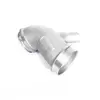Mobile:+86-311-808-126-83
Email:info@ydcastings.com
impeller in submersible pump
The Role of Impellers in Submersible Pumps
Submersible pumps are a critical component in various applications, from wastewater management and agricultural irrigation to residential drainage and industrial processes. At the heart of these pumps lies a vital component known as the impeller. Understanding the structure and function of the impeller in submersible pumps not only sheds light on the operation of these machines but also aids in their effective selection and maintenance.
What is an Impeller?
An impeller is a rotating component of a pump that transfers energy from the motor to the fluid. Typically designed with blades, impellers create a vortex, pushing fluid through the pump as they spin. In submersible pumps, which operate underwater, the impeller is crucial for achieving the necessary flow rates, head (the height that the pump can effectively move fluid), and overall efficiency.
Types of Impellers
There are several types of impellers used in submersible pumps, each designed for specific conditions and applications. The most common types include
1. Open Impellers These impellers have blades that are not enclosed by a shroud. They are typically used in applications where the fluid contains solids or is corrosive, as they can handle larger particles without clogging. Open impellers are usually simpler to manufacture and maintain.
2. Closed Impellers These consist of blades that are enclosed by a front and rear shroud. They are generally more efficient than open impellers and are suited for clean liquids. Closed impellers are used in applications requiring high pressure or flow rates.
3. Semi-Open Impellers These are a hybrid between open and closed impellers, housing blades on one side while keeping the other side open. They offer a balance between efficiency and the ability to handle larger solids, making them versatile for various fluids.
impeller in submersible pump

How Impellers Function in Submersible Pumps
When a submersible pump is submerged in water or any fluid, the impeller begins to rotate, driven by an electric motor. The rotation creates a low-pressure area at the center of the impeller, causing fluid to flow into the pump. As the fluid enters, the impeller blades impart velocity to it, converting the mechanical energy from the motor into kinetic energy. This energy is then transformed into pressure energy as the fluid exits, allowing it to rise through the pump and into the discharge pipe.
The design of the impeller plays a significant role in the pump's performance. The number of blades, the angle, and the overall shape can greatly influence the flow rate and the energy efficiency of the pump. For instance, impellers with a larger diameter can move more fluid but may require more energy, while smaller impellers can operate at higher speeds, increasing efficiency but potentially reducing flow capacity.
Maintenance Considerations
Proper maintenance of impellers is crucial for the longevity and efficiency of submersible pumps. Regular inspections can help identify wear, corrosion, or blockages in the impeller, which can lead to decreased performance or complete pump failure. In systems dealing with solids or abrasive materials, it is essential to choose the right type of impeller to minimize wear and tear.
Moreover, understanding the application environment can aid in selecting the correct materials for impeller construction. For example, impellers used in harsh chemicals or brackish water may need to be made from stainless steel or specialized plastics to enhance durability.
Conclusion
In summary, the impeller is a fundamental component of submersible pumps that significantly impacts their efficiency and effectiveness. By understanding the different types of impellers, their functionality, and maintenance requirements, users can make informed decisions regarding the selection and upkeep of submersible pumps. This knowledge not only ensures optimal performance but also extends the lifespan of these invaluable machines in various applications. Whether for groundwater extraction, sewage pumping, or industrial liquid transport, the role of the impeller in submersible pumps remains indispensable.
-
Impeller Technology That Powers Precision in Pump SystemsNewsMay.22,2025
-
Valve Durability Begins with Quality Cast Iron ComponentsNewsMay.22,2025
-
Performance Cooling with Advanced Automobile Water Pump SolutionsNewsMay.22,2025
-
How Motor Housing and Oil Pans Shape Engine PerformanceNewsMay.22,2025
-
How Metal Castings Drive Modern Manufacturing EfficiencyNewsMay.22,2025
-
Exploring the Engineering Behind Valve Body CastingsNewsMay.22,2025











